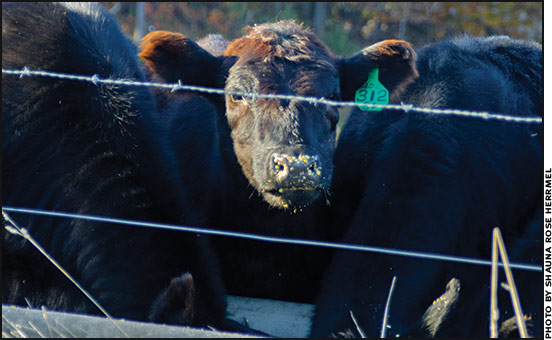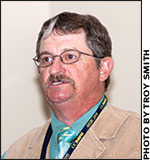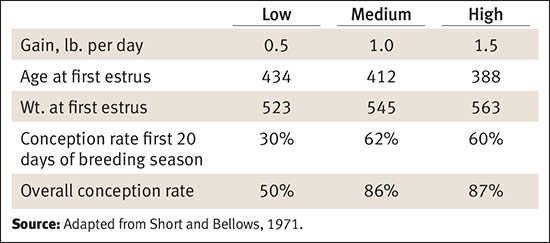
Heifer Development:
Same Challenges, More Options
Producing replacement females is one of the most important and costly enterprises for cow-calf operations. Generally speaking, producers want to develop replacement heifers in a way that will make them productive members of the breeding herd for a long time.

“Using the 55% target weight will be fine for some operations, but not for others,” said John Hall, University of Idaho.
“We all have some limitations, based on our environment and feed resources, but we still enjoy a lot of flexibility in how we can develop heifers,” said University of Idaho animal scientist John Hall during this August’s Applied Reproductive Strategies in Beef Cattle (ARSBC) conference.
Reminding his audience that nutrition is the area of management most controlled by the producer, Hall offered food for thought regarding both pre- and postweaning nutrition. He advised producers to start early to prepare replacement candidates to become pregnant early in their first breeding season.
Hall cited research showing how heifers that conceived in the first 21 days of the breeding season remained in the herd longer and produced more total pounds of weaned calf weight through six calvings. He noted how synchronized artificial insemination (AI) is a proven technology for increasing the percentage of heifers that conceive early in the breeding season. However, heifers must be properly developed to be suitable candidates for synchronized AI.
While most heifer-development programs focus on the postweaning period, Hall suggested producers pay attention to growth of heifer calves prior to weaning. This could be particularly important for producers affected by drought or other conditions that might cause forage nutrient restriction. He noted research suggesting calf nutrition prior to 6 months of age is critical to potential replacement females. Creep-feeding or creep-grazing may be worth consideration where applicable.
“This might require a change of thinking for many of us, but we might need to monitor preweaning nutrition more closely,” said Hall, calling early weaning another strategy worth consideration, particularly in drought.
Hall said the majority of studies of nutritional impacts on heifer development and reproduction have focused on the postweaning period. From that research has come the standard recommendation that heifer diets target gains averaging 1.25 pounds (lb.) to 1.75 lb. per day during the period between weaning and breeding (see Table 1). Hall said the pattern of gain, whether slow at first and followed by more rapid gain during the last 60 days of development or steady gain throughout development, does not matter. As long as heifers reach an appropriate target weight by breeding time, reproductive performance should not be affected.

Addressing the target weight debate, Hall said targeting 65% of expected mature weight is a well-researched strategy that probably is “more forgiving” and ensures that a large percentage of heifers will be pubertal by the beginning of breeding season. Multiple studies have shown that heifers developed to 55% of mature weight did not reduce the percentage of heifers becoming pregnant in the first 21 days of the breeding season. Other research resulted in up to 15% fewer heifers conceiving early in the breeding season, compared to heifers developed to the heavier target.
“Using the 55% target weight will be fine for some operations, but not for others,” said Hall, noting that it is likely better suited to crossbred or composite cattle, which generally reach puberty at a younger age than do straightbred cattle.
Hall advised producers to include ionophores in heifer development diets and warned against use of growth implants. To make sure heifers are adapted to the production environments, he recommended using feedstuffs and grazing resources similar to what heifers will be exposed to as cows.
Hall spoke during Monday’s ARSBC session focused on females. Visit the Newsroom at www.appliedreprostrategies.com to view his PowerPoint, read the proceedings or listen to his presentation.

Editor’s Note: Troy Smith is a freelance writer and cattleman from Sargent, Neb. Comprehensive coverage of the symposium is available online at www.appliedreprostrategies.com. Compiled by the Angus Journal editorial team, the site is made possible through sponsorship by the Beef Reproduction Task Force.





